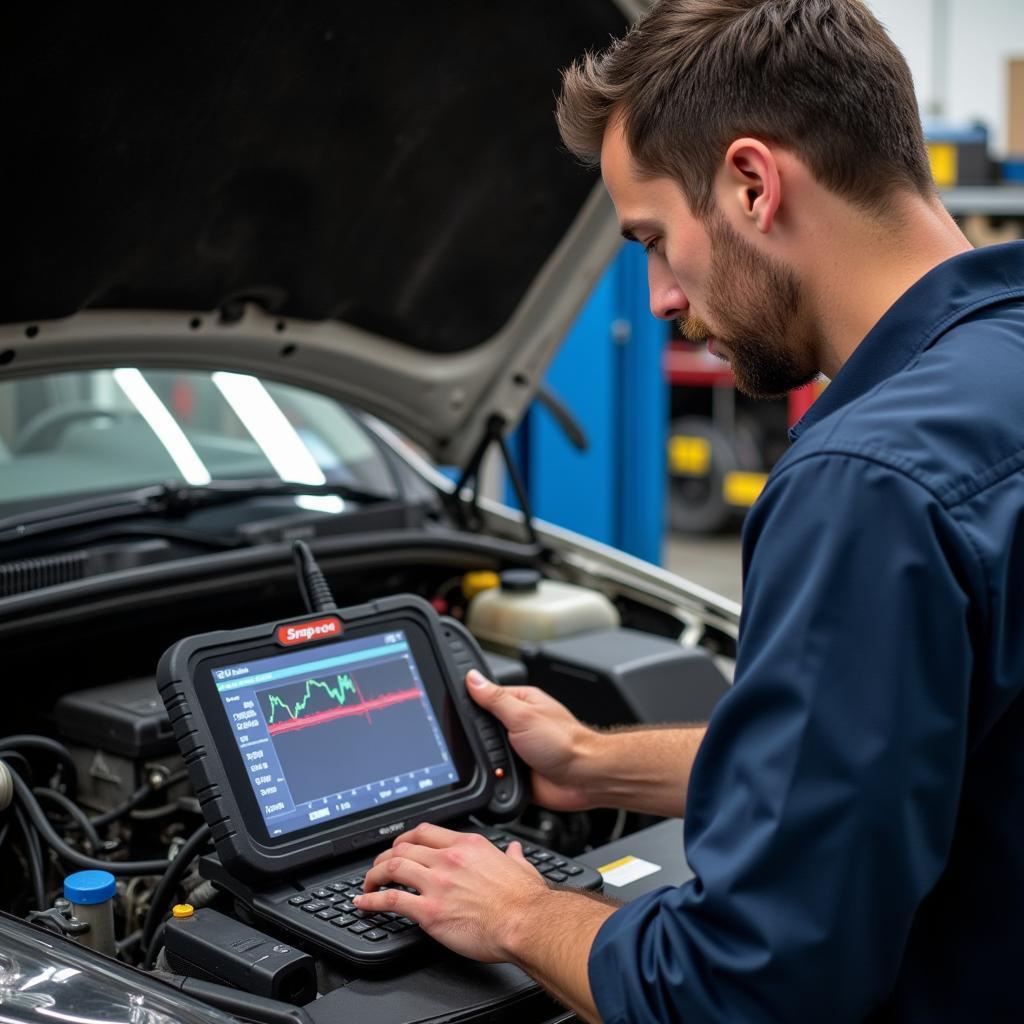Snap-on diagnostics in car technology have revolutionized the way we diagnose and repair vehicles. Gone are the days of relying solely on mechanical expertise and guesswork. Today, sophisticated diagnostic tools provide a window into a car’s complex electronic systems, enabling technicians to pinpoint issues with incredible accuracy.
What are Snap Diagnostics in Car Technology?
Snap-on diagnostics refer to a suite of advanced tools and software developed by Snap-on, a leading name in the automotive repair industry. These tools, often housed in handheld devices or integrated into larger diagnostic systems, communicate with a vehicle’s onboard computer systems to retrieve valuable data.
Think of it like this: your car is constantly monitoring its own health, collecting data from various sensors and systems. Snap-on diagnostic tools act as a translator, allowing technicians to understand this data and identify potential problems.
The Benefits of Using Snap Diagnostics in Car Repair
The use of Snap-on diagnostics in car repair offers numerous advantages over traditional methods:
- Precision Diagnosis: Snap-on tools can accurately identify the root cause of a problem, eliminating guesswork and unnecessary repairs.
- Increased Efficiency: By quickly pinpointing issues, these tools save technicians valuable time, resulting in faster turnaround times for car owners.
- Comprehensive Data: Snap-on diagnostics provide access to a wide range of data points, including engine performance, transmission behavior, emissions systems, and much more.
- Advanced Troubleshooting: Many Snap-on tools offer features like guided troubleshooting, technical diagrams, and repair information databases, assisting technicians in complex repairs.
How Snap Diagnostics Work
Snap-on diagnostics utilize the OBD-II port, a standardized connector found in most vehicles manufactured after 1996. This port acts as a gateway to the vehicle’s onboard computer network. By connecting to the OBD-II port, Snap-on tools can:
- Read Diagnostic Trouble Codes (DTCs): These codes are stored by the vehicle’s computer when it detects a malfunction. Snap-on tools can retrieve and interpret these codes, providing valuable clues about the problem.
- View Live Data Streams: Technicians can monitor real-time data from various sensors and systems, such as engine RPM, coolant temperature, oxygen sensor readings, and more. This helps to analyze system performance and identify anomalies.
- Run Actuator Tests: Snap-on tools can command specific components, like actuators and solenoids, to operate. This allows technicians to verify component functionality and isolate faulty parts.
- Perform Software Updates: In some cases, vehicle software updates may be required to address specific issues or improve performance. Snap-on tools can facilitate these updates, ensuring the vehicle’s software is up-to-date.
Snap Diagnostics: An Indispensable Tool for Modern Car Repair
As vehicles become increasingly complex, relying solely on traditional diagnostic methods is no longer sufficient. Snap diagnostics in car repair are essential for accurately identifying and resolving issues. These tools provide technicians with the insights and information they need to keep vehicles running smoothly. Whether you’re a car owner or a professional mechanic, understanding the capabilities of Snap-on diagnostics is crucial in today’s automotive landscape.
FAQs About Snap Diagnostics
Q: Can I use Snap-on diagnostics on my own car?
While some Snap-on tools are available for consumer use, their full capabilities are best utilized by trained professionals.
Q: Are Snap-on diagnostics compatible with all car makes and models?
Snap-on offers a wide range of tools and software designed to work with various vehicle makes and models. However, it’s essential to choose the appropriate tool for your specific vehicle.
Q: What is the cost of using Snap-on diagnostics?
The cost can vary depending on the complexity of the diagnosis and the specific tools used. It’s best to consult with a qualified mechanic for an estimate.
 Mechanic Reviewing Diagnostic Data on Snap-on Tool
Mechanic Reviewing Diagnostic Data on Snap-on Tool
Need Help with Car Diagnostics?
For all your car diagnostic needs, contact us via WhatsApp: +1(641)206-8880, Email: [email protected]. Our team of experts is available 24/7 to assist you. You can also find more helpful articles on snap diagnostics in car and snape and diagnostics in car.
Learn more about specific diagnostic services, like our car diagnostic test sheffield or information about car diagnostic port lock.

Leave a Reply